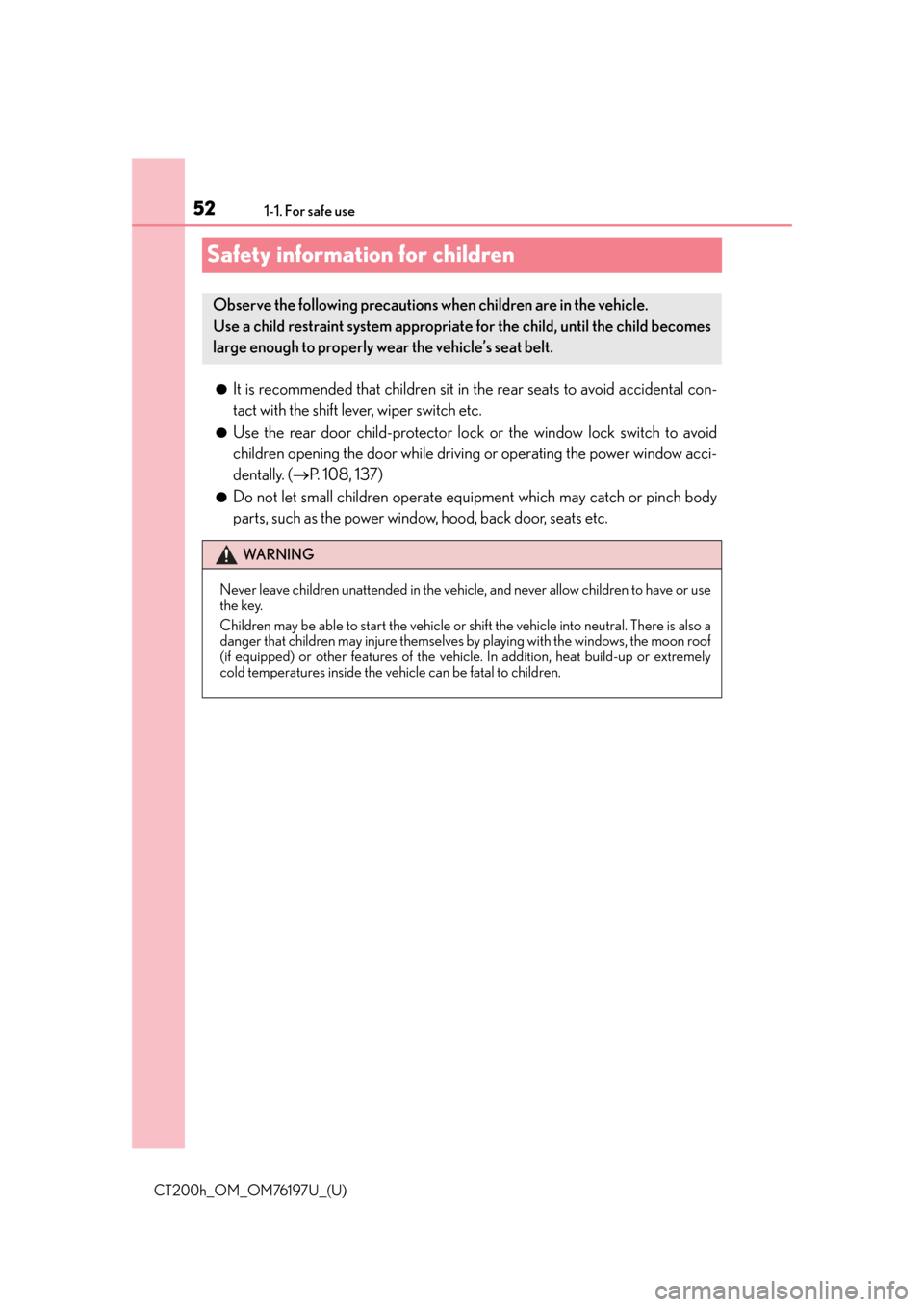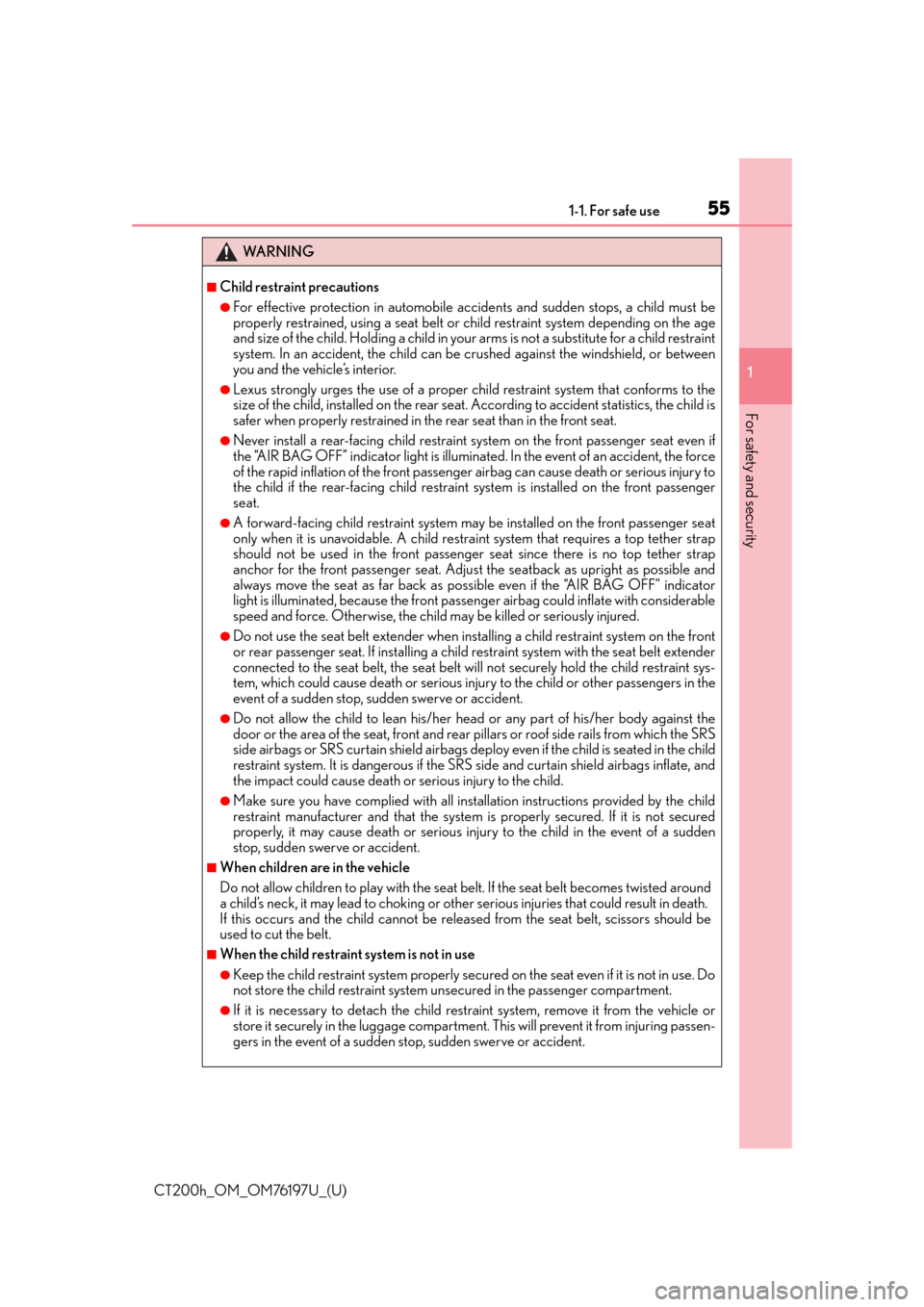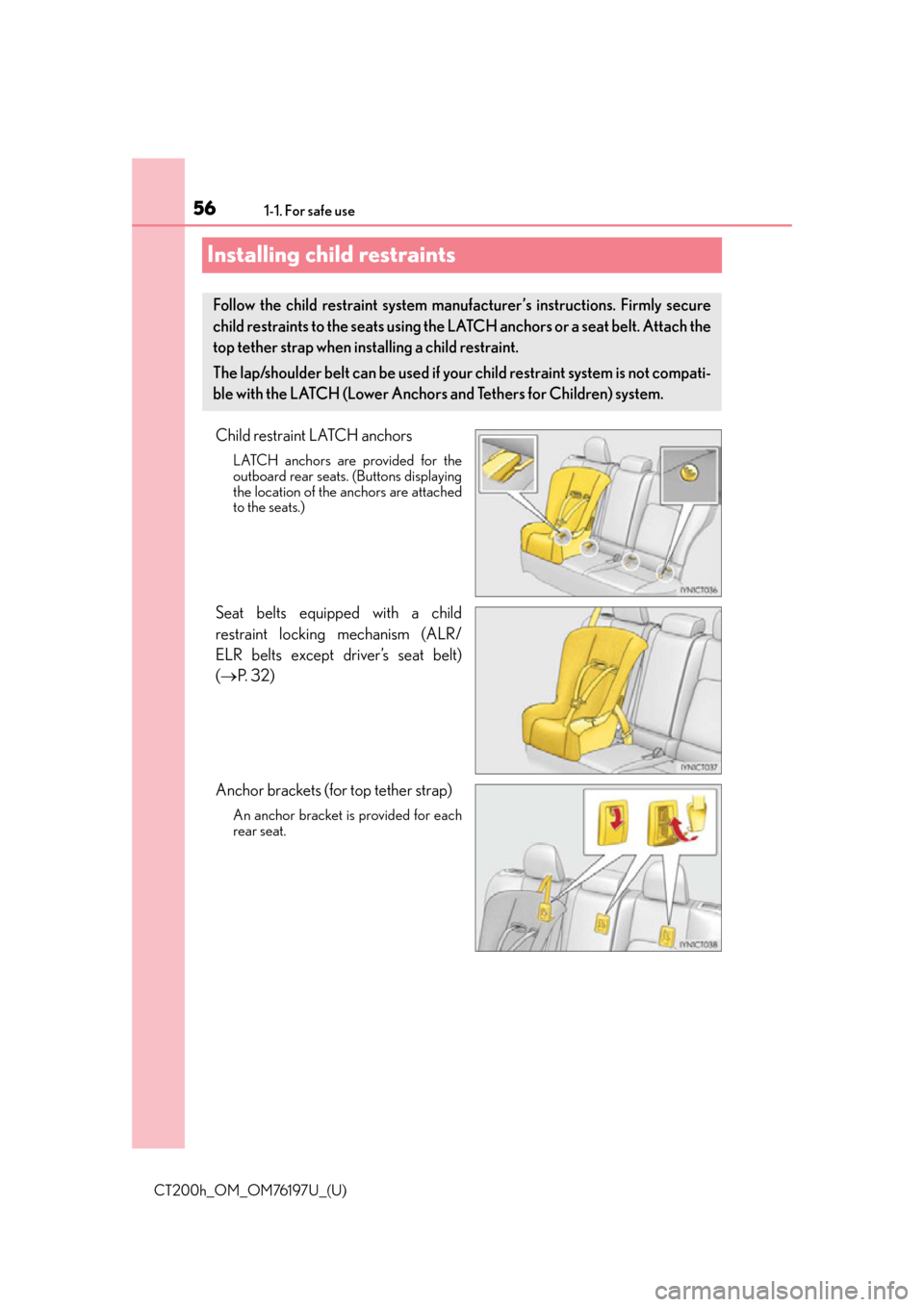Lexus CT200h 2016 (in English) Workshop Manual
Manufacturer: LEXUS, Model Year: 2016, Model line: CT200h, Model: Lexus CT200h 2016Pages: 632, PDF Size: 8.5 MB
Page 51 of 632

511-1. For safe use
CT200h_OM_OM76197U_(U)
1
For safety and security
WA R N I N G
■Front passenger occupant classification system precautions
●Do not recline the front passenger seatback so far that it touches a rear seat. This may
cause the “AIR BAG OFF” indicator light to be illuminated, which indicates that the
SRS airbags for the front passenger will not activate in the event of a severe accident.
If the seatback touches the rear seat, return the seatback to a position where it does
not touch the rear seat. Keep the front passenger seatback as upright as possible
when the vehicle is moving. Reclining the seatback excessively may lessen the effec-
tiveness of the seat belt system.
●If an adult sits in the front passenger seat , the “AIR BAG ON” indicator light is illumi-
nated. If the “AIR BAG OFF” indicator is illuminated, ask the passenger to sit up
straight, well back in the seat, feet on the floor, and with the seat belt worn correctly. If
the “AIR BAG OFF” indicator still remains illuminated, either ask the passenger to
move to the rear seat, or if that is not possible, move the front passenger seat fully
rearward.
●When it is unavoidable to install a forward- facing child restraint system on the front
passenger seat, install the child restraint sy stem on the front passenger seat in the
proper order. ( P. 5 6 )
●Do not modify or remove the front seats.
●Do not kick the front passenger seat or subj ect it to severe impact. Otherwise, the
SRS warning light may come on to indicat e a malfunction of the front passenger
occupant classification system. In this ca se, contact your Lexus dealer immediately.
●Child restraint systems installed on the rear seat should not contact the front seat-
backs.
●Do not use a seat accessory, such as a cu shion and seat cover, that covers the seat
cushion surface.
●Do not modify or replace the upholstery of the front seat.
Page 52 of 632

521-1. For safe use
CT200h_OM_OM76197U_(U)
Safety information for children
●It is recommended that children sit in the rear seats to avoid accidental con-
tact with the shift lever, wiper switch etc.
●Use the rear door child-protector lock or the window lock switch to avoid
children opening the door while driving or operating the power window acci-
dentally. ( P. 1 0 8 , 1 3 7 )
●Do not let small children operate equi pment which may catch or pinch body
parts, such as the power window, hood, back door, seats etc.
Observe the following precautions when children are in the vehicle.
Use a child restraint system appropriate for the child, until the child becomes
large enough to properly wear the vehicle’s seat belt.
WA R N I N G
Never leave children unattended in the vehicle, and never allow children to have or use
the key.
Children may be able to start the vehicle or sh ift the vehicle into neutral. There is also a
danger that children may injure themselves by playing with the windows, the moon roof
(if equipped) or other features of the vehicle. In addition, heat build-up or extremely
cold temperatures inside the vehicle can be fatal to children.
Page 53 of 632

531-1. For safe use
CT200h_OM_OM76197U_(U)
1
For safety and security
Child restraint systems
●Choose a child restraint system that suits your vehicle and is appropriate to
the age and size of the child.
●For installation details, follow the instruct ions provided with the child restraint
system.
General installation instructions are provided in this manual. (P. 5 6 )
A child restraint system for a small child or baby must itself be properly
restrained on the seat with the LATCH anchors or the lap portion of the lap/
shoulder belt.
The laws of all 50 states of the U.S.A. and Canada now require the use of child
restraint systems.
Points to remember
Page 54 of 632

541-1. For safe use
CT200h_OM_OM76197U_(U)
Child restraint systems are classified into the following 3 types according to the
age and size of the child.
■When installing a child restraint system on the front passenger seat
When you have to use a child restraint system on the front passenger seat, adjust the fol-
lowing:
■Selecting an appropriate child restraint system
●Use a child restraint system appropriate fo r the child until the child becomes large
enough to properly wear the vehicle’s seat belt.
●If the child is too large for a child restraint system, sit the ch ild on a rear seat and use the
vehicle’s seat belt. ( P. 3 2 )
Types of child restraints
Rear facing Infant seat/convert-
ible seatForward facing Convertible
seat
Booster seat
●The seatback to the most upright position
●The seat cushion to the fully rearward position
Page 55 of 632

551-1. For safe use
CT200h_OM_OM76197U_(U)
1
For safety and security
WA R N I N G
■Child restraint precautions
●For effective protection in automobile a ccidents and sudden stops, a child must be
properly restrained, using a se at belt or child restraint system depending on the age
and size of the child. Holding a child in your arms is not a substitute for a child restraint
system. In an accident, the child can be crushed against the windshield, or between
you and the vehicle’s interior.
●Lexus strongly urges the use of a proper child restraint system that conforms to the
size of the child, installed on the rear seat . According to accident statistics, the child is
safer when properly restrained in th e rear seat than in the front seat.
●Never install a rear-facing child restraint system on the front passenger seat even if
the “AIR BAG OFF” indicator lig ht is illuminated. In the event of an accident, the force
of the rapid inflation of the front passenger airbag can cause death or serious injury to
the child if the rear-facing child restraint system is installed on the front passenger
seat.
●A forward-facing child restraint system ma y be installed on the front passenger seat
only when it is unavoidable. A child restra int system that requires a top tether strap
should not be used in the front passenger seat since there is no top tether strap
anchor for the front passenger seat. Adjust the seatback as upright as possible and
always move the seat as far back as possible even if the “AIR BAG OFF” indicator
light is illuminated, because the front passenger airbag could inflate with considerable
speed and force. Otherwise, the child may be killed or seriously injured.
●Do not use the seat belt extender when inst alling a child restraint system on the front
or rear passenger seat. If installing a child restraint system with the seat belt extender
connected to the seat belt, the seat belt w ill not securely hold the child restraint sys-
tem, which could cause death or serious injury to the child or other passengers in the
event of a sudden stop, sudden swerve or accident.
●Do not allow the child to lean his/her head or any part of his/her body against the
door or the area of the seat, front and rear pillars or roof side rails from which the SRS
side airbags or SRS curtain shield airbags depl oy even if the child is seated in the child
restraint system. It is dangerous if the SRS side and curtain shield airbags inflate, and
the impact could cause death or serious injury to the child.
●Make sure you have complied with all insta llation instructions provided by the child
restraint manufacturer and that the system is properly secured. If it is not secured
properly, it may cause death or serious inju ry to the child in the event of a sudden
stop, sudden swerve or accident.
■When children are in the vehicle
Do not allow children to play with the seat belt. If the seat belt becomes twisted around
a child’s neck, it may lead to choking or othe r serious injuries that could result in death.
If this occurs and the child cannot be released from the seat belt, scissors should be
used to cut the belt.
■When the child restraint system is not in use
●Keep the child restraint system properly secured on the seat even if it is not in use. Do
not store the child restraint system unsecured in the passenger compartment.
●If it is necessary to detach the child rest raint system, remove it from the vehicle or
store it securely in the luggage compartment. This will prevent it from injuring passen-
gers in the event of a sudden stop, sudden swerve or accident.
Page 56 of 632

561-1. For safe use
CT200h_OM_OM76197U_(U)
Installing child restraints
Child restraint LATCH anchors
LATCH anchors are provided for the
outboard rear seats. (Buttons displaying
the location of the anchors are attached
to the seats.)
Seat belts equipped with a child
restraint locking mechanism (ALR/
ELR belts except driver’s seat belt)
( P. 3 2 )
Anchor brackets (for top tether strap)
An anchor bracket is provided for each
rear seat.
Follow the child restraint system manu facturer’s instructions. Firmly secure
child restraints to the seat s using the LATCH anchors or a seat belt. Attach the
top tether strap when installing a child restraint.
The lap/shoulder belt can be used if yo ur child restraint system is not compati-
ble with the LATCH (Lower Anchor s and Tethers for Children) system.
Page 57 of 632

571-1. For safe use
CT200h_OM_OM76197U_(U)
1
For safety and security
Open the fasteners on the lower
part of the seatback.
Ty p e A
Latch the hooks of the lower straps
onto the LATCH anchors. If the child
restraint has a top tether strap, the
top tether strap should be latched
onto the top tether strap anchor.
For owners in Canada:
The symbol on a child restraint sys-
tem indicates the presence of a
lower connector system.
Installation with LATCH system
1
Canada only
2
Page 58 of 632

581-1. For safe use
CT200h_OM_OM76197U_(U)
Ty p e B
Latch the buckles onto the LATCH
anchors. If the child restraint has a
top tether strap, the top tether strap
should be latched onto the top
tether strap anchor.
For owners in Canada:
The symbol on a child restraint sys-
tem indicates the presence of a
lower connector system.
■Rear facing Infant seat/convertible seat
Place the child restraint system
on the rear seat facing the rear of
the vehicle.
Run the seat belt through the
child restraint system and insert
the plate into the buckle. Make
sure that the belt is not twisted.
Canada only
2
Installing child restraints using a se at belt (child restraint lock function
belt)
1
2
Page 59 of 632

591-1. For safe use
CT200h_OM_OM76197U_(U)
1
For safety and security
Fully extend the shoulder belt and
allow it to retract to put it in lock
mode. In lock mode, the belt can-
not be extended.
While pushing the child restraint
system down into the rear seat,
allow the shoulder belt to retract
until the child restraint system is
securely in place.
After the shoulder belt has retracted
to a point where there is no slack in
the belt, pull the belt to check that it
cannot be extended.
■For ward-facing Convertible seat
Place the child restraint system
on the seat facing the front of the
vehicle.
Run the seat belt through the
child restraint system and insert
the plate into the buckle. Make
sure that the belt is not twisted.
3
4
1
2
Page 60 of 632

601-1. For safe use
CT200h_OM_OM76197U_(U)
Fully extend the shoulder belt and
allow it to retract to put it in lock
mode. In lock mode, the belt can-
not be extended.
While pushing the child restraint
system into the rear seat, allow
the shoulder belt to retract until
the child restraint system is
securely in place.
After the shoulder belt has retracted
to a point where there is no slack in
the belt, pull the belt to check that it
cannot be extended.
If the child restraint has a top tether strap, the top tether strap should be
latched onto the top tether strap anchor. (P. 6 1 )
■Booster seat
Place the child restraint system
on the seat facing the front of the
vehicle.
Sit the child in the child restraint
system. Fit the seat belt to the
child restraint system according
to the manufacturer’s instructions
and insert the plate into the
buckle. Make sure that the belt is
not twisted.
Check that the shoulder belt is cor-
rectly positioned over the child’s
shoulder and that the lap belt is as
low as possible. ( P. 3 2 )
3
4
5
1
2